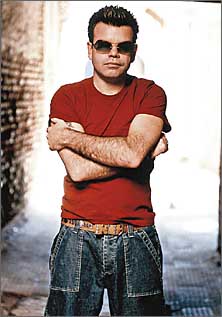|
The Science of Music - S'Kiri
Article originally written in February 2001 for eJaynet |
|

|
|
Ever wondered why some tracks really get everyone up dancing while others leave you cold?
Want to know how to guarantee you'll get the girls on the floor with your latest killer mix?
Well, those of you who know the tricks of the trade, leave now whilst S'Kiri fills the rest of you in on the science of dance music..
OK, hands up here, though I knew most of this already - honest! - this article has been drawn from two excellent articles, one in Computer Music magazine, the other in Mixmag so those of you who have got these mags will find this familiar... |
|
OK! Well firstly, take dance music - usually you'll find the tempo at around 140bpm. Yeah, well, so what, I hear you ask? Well, it has been scientifically proven that the heart rate while dancing is increased by an exact tempo of 137bpm. Hence, if dance music has a tempo of around 140, you can guarantee it'll keep 'em on the floor. In non-dance music, tension can be added to a track by starting off at around 130bpm and edging it up throughout the mix until it hits about 134 - this adds to the excitement of a track and carries the listener along with it.
Then there is good old bass: "It's the lower sounds - the kick drum and the bassline - that keep people rooted to the floor," says Tom Middleton of Global Communication. "Then, if you add the really high frequencies and remove the bass, people always put their hands in the air. High frequencies make your brain resonate more than your physical organs, which interferes with alpha and beta waves in the brain. If you were to play a beat and then fade in some high frequencies like white noise, then fade out the beat, I can almost guarantee you people will go nuts!"
And you thought you had free will....!! |

Tom Middleton - "High frequencies make you want to put your hands in the air" |
|
There is a guy at Manchester University, Neil Todd, who researches the effects of dance music on the human body - he uses techno for his research. He found that bass over 90db stimulates the inner ear, which controls balance - the brain then interprets this as movement so you already think you are swinging to the beat without moving a muscle!
And then there is the effect bass has on women.... Apparently we poor things are irresistibly drawn to bass (medical fact here, folks!) because of their similarity to low frequency mating calls - even fish respond to them... So, if you want to get the girls up on the dancefloor, roll out the bass!!
Next let's look at resonance produced by low frequency vibrations - as anyone knows who has been in a club -you can FEEL the bass and the drumline, not just hear it - and if you find the resonance frequency of the human body, you can kill with it!! This fact is used by the military to produce sonic weapons - now don't some of you out there get ideas!!
There are also tricks to keep the energy levels high when paying tracks in a club. To explain this let me introduce you to the rising tone phenomenon - it is a sonic illusion, which you can hear on the Exploratorium Science Museum of San Francisco site. It's a computer generated sound which uses complex harmonies to give the impression it is always rising in pitch - you could listen to it for days and it would still sound like it was rising... |
|

Paul Oakenfold - "Minor keys make you feel sad and major ones make you feel happy" |
This is what good DJ's do when they mix tracks, blending one track into the next so that the energy level feels as if it is constantly rising.
A similar effect can be produced by ordering tracks in a set to produce a progression of keys... which is what Paul Oakenfold does - he says, "Keys are a very important thing because they mess with you feelings...minor keys make you feel down, solemn, sad. A major key makes you feel happy." Ahhh..that's why some of you guys are giving eJay a rest - A minor overdose!
And what's with dance music's penchant for the sudden stop? Ah, well, you see, since dance music is so repetitive, the brain starts to accept it as part of the sonic wallpaper, so to speak, part of the natural background noise.
Suddenly removing this background causes a jolt to the brain in a similar way to switching off a light and grabs people's attention... "Sheer relentless repetition hypnotises you", says progressive trancer Danny Howells. "If you've got a track really grooving along and it drops out for a bar, when it comes back with the kick drum and bass-line, you're pretty much guaranteed to cause a stir!" |
|
Tips from Dave Lee aka Joey Negro: "If I wanted a sure fire track, I'd have lots of drops, bass drum fills, climaxing up to when the kick drum comes back in. To make a crowd really lose it you want to use as many effects as possible, all swelling up with a sample filtering up and down during the drops - and when the drums come in, you want a something like a siren."
Now, you can't overdo all these effects, 'cos the poor old brain can only cope with so much at one time, otherwise it just turns into mush. About five or six different distinct sounds at one time (all the drums included as one) is about the limit before the brain goes into overload and just merges them altogether. (The mute facility on your sequencer is good for telling whether that wonderfully crafted bit you spent three hours on last night can actually be heard above the rest of the track!) |
|
And leave some room for the hook line - it's the part that grabs the listener's attention and if you get it wrong, then the rest of the track will sound hopeless... The best way to create a hook is to make it sound unusual and the best subject for this is the human voice. Since we have all grown up listening to voices, we are familiar with them and therefore tweaking vocals is a sure fire way of grabbing people's attention, which is why vocoders have been so fashionable recently.
Computer Music magazine gives reams of brilliant advice about how to treat vocals to make them arresting but I thought this would be too cruel for sensitive readers reliant on eJay for their vocals...
How about the beginning of your track? This is always a hard choice... Do you build up slowly or start with a thundering riff? Well, back to the poor old brain again... It hasn't got much of an attention span and doesn't want to wait to get to the interesting bit 2 minutes down the line, so you need to get your message across pretty fast. However if you are aspiring to be heard in a club, a good trick is to start with 8 bars of a drumloop - uninspiring, but it's easier for the DJ to mix in your track and if it's easier for him, he is likely to play it more... |

Danny Howells - "If a track is grooving along and you drop it out for a bar, when it comes back in with the kick drum and bass-line, you're pretty much guaranteed to cause a stir" |
|
So, most of the tricks of the trade are reliant on the brain's perception of sound and you can trick it quite cleverly - note the use of layering and offsetting of samples in eJay which produces some great mixes.
So now you know - go out and make killer tracks!!
References:
Computer Music: Issue 29 The CM Guide to Arranging pp 59-63
MixMag: Issue 116 How does music work? pp70-75 |
|
- Lynn Parry (S'Kiri / Skizza)
February 2001. |